 It’s been a long time coming after being announced way back at CES in January 2007, but word is that iRiver’s B20 is finally about to start shipping.
It’s been a long time coming after being announced way back at CES in January 2007, but word is that iRiver’s B20 is finally about to start shipping.
It’s a lovely looking thing too, packing a ton of functionality into its diminutive dimensions, with the business end dominated by a 2.4inch 260,000 colour TFT-LCD display.
Inside there’s a feast of techno-gubbins taking care of your every multimedia need, with the device ready and willing to play about with movies, music, pictures, videos, text and digital broadcasting.
There’s support for MP3, WMA, OGG, AVI (MPEG4), WMV9, JPG playback, as well as an onboard FM radio with programmable FM recording, T-DMB recording, a voice recorder and alarm.
 Battery life is claimed at up to 17 hours for MP3 playback, 4 hours for video, 7 hours for DAB, dropping down to just 4 hours for DMB (Digital Multimedia Broadcasting).
Battery life is claimed at up to 17 hours for MP3 playback, 4 hours for video, 7 hours for DAB, dropping down to just 4 hours for DMB (Digital Multimedia Broadcasting).
The player comes in 2GB and 4GB flash memory flavours and there’s a Mini SD card slot for expansion.
Pricing should be around €164 for the 2GB version and €206 for the 4Gb jobbie.
Specs:
Display: 2.4inch 260,000 colour TFT-LCD display
Triple-band support (Band 3 + Band L + Analogue FM)
Frequency: 174MHz~240MHz(Band 3), 1.452GHz~1.492GHz(Band L)
1GB/2GB/4GB flash memory capacity, with Mini SD card expansion slot
Built in T-DMB recording
Integrated FM Tuner, voice recorder and alarm
Supported file types: MP3, WMA, OGG, AVI (MPEG4), WMV9, JPG
Battery life up to 17 hours (MP3), 4 hours (Video), 7 hours (DAB), 4 hours (DMB)
iRiver D-Click System navigation
Built in speaker
Source
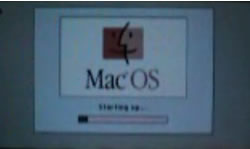 We know you love it when people port software on to unlikely platforms, so thought you’d like to see this video of the old (pre-osx) Mac operating system running on an Sony PSP.
We know you love it when people port software on to unlikely platforms, so thought you’d like to see this video of the old (pre-osx) Mac operating system running on an Sony PSP.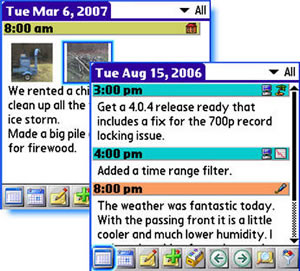 Touted as a “business and personal journal for the Palm OS or Pocket PC,” DayNotez is a powerful companion to your handheld’s built in diary application.
Touted as a “business and personal journal for the Palm OS or Pocket PC,” DayNotez is a powerful companion to your handheld’s built in diary application.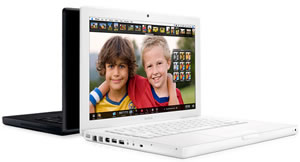 The adage “Everything comes to those who wait” will ring true for punters who have been umming and ahhing about getting a new MacBook.
The adage “Everything comes to those who wait” will ring true for punters who have been umming and ahhing about getting a new MacBook. The breakdown on the UK prices are 2.0 GHz (80Gb H/D and slot-load Combo (DVD-ROM/CD-RW) optical drive – £699; 2.16 GHz White (120GB H/D and slot-load 8x SuperDrive with double-layer support (DVD+R DL/DVD±RW/CD-RW) optical drive) – £829; 2.16 GHz Black (160GB H/D and same SuperDrive) – £949.
The breakdown on the UK prices are 2.0 GHz (80Gb H/D and slot-load Combo (DVD-ROM/CD-RW) optical drive – £699; 2.16 GHz White (120GB H/D and slot-load 8x SuperDrive with double-layer support (DVD+R DL/DVD±RW/CD-RW) optical drive) – £829; 2.16 GHz Black (160GB H/D and same SuperDrive) – £949.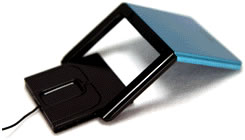 When I travel, I always look for ways to try and reduce the bulk of what I have to carry.
When I travel, I always look for ways to try and reduce the bulk of what I have to carry. You can always rely on Brando to bring a smile to your face with some completely daft USB gizmo, and once again they haven’t disappointed with the release of their USB Roll-Up Drum Kit and keyboard.
You can always rely on Brando to bring a smile to your face with some completely daft USB gizmo, and once again they haven’t disappointed with the release of their USB Roll-Up Drum Kit and keyboard.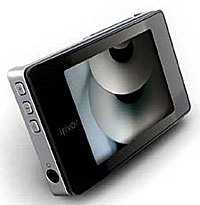 It’s been a long time coming after being announced way back at CES in January 2007, but word is that iRiver’s B20 is finally about to start shipping.
It’s been a long time coming after being announced way back at CES in January 2007, but word is that iRiver’s B20 is finally about to start shipping.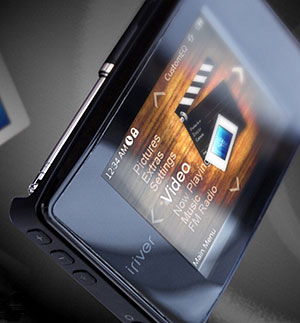 Battery life is claimed at up to 17 hours for MP3 playback, 4 hours for video, 7 hours for DAB, dropping down to just 4 hours for DMB (Digital Multimedia Broadcasting).
Battery life is claimed at up to 17 hours for MP3 playback, 4 hours for video, 7 hours for DAB, dropping down to just 4 hours for DMB (Digital Multimedia Broadcasting).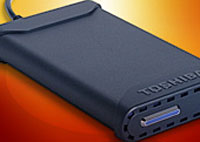 With its feeble 1.44MB storage space, that often meant you had to cart around great boxes of the things.
With its feeble 1.44MB storage space, that often meant you had to cart around great boxes of the things. With this in mind, Toshiba – the world’s fifth-largest hard drive manufacturer – has decided to elbow its way into the portable drive market with its 2.5-inch USB 2.0 portable external hard drive offering a positively palatial 200GB of storage space. That works out at 57,000 digital photos, 52,000 MP3 songs or 88 DVD videos all wedged into its slimline case (approx 6″x4″x0.9″).
With this in mind, Toshiba – the world’s fifth-largest hard drive manufacturer – has decided to elbow its way into the portable drive market with its 2.5-inch USB 2.0 portable external hard drive offering a positively palatial 200GB of storage space. That works out at 57,000 digital photos, 52,000 MP3 songs or 88 DVD videos all wedged into its slimline case (approx 6″x4″x0.9″). Intel is getting ready to release its own version of the mini-tablet, with
Intel is getting ready to release its own version of the mini-tablet, with 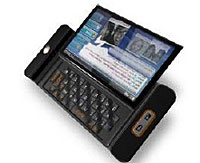 Expected to be released next year, the UMPCs are tipped to be an extension of the successful Centrino mobile brand, with the CPU components (codenamed Stealey) packing dual-core processors clocked at 600-800MHz.
Expected to be released next year, the UMPCs are tipped to be an extension of the successful Centrino mobile brand, with the CPU components (codenamed Stealey) packing dual-core processors clocked at 600-800MHz.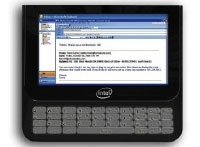 Intel’s new gizmo is looking to woo punters with a seductive mobile mix of email, web, entertainment, information and location-based services, including the trusty Google Maps application and Web-based “office and enterprise applications.”
Intel’s new gizmo is looking to woo punters with a seductive mobile mix of email, web, entertainment, information and location-based services, including the trusty Google Maps application and Web-based “office and enterprise applications.”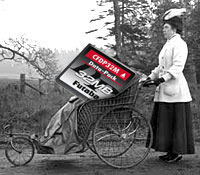 The two companies have revealed details about their Memorandum of Understanding (MOU) to develop a new SxS memory card format for professional camcorders.
The two companies have revealed details about their Memorandum of Understanding (MOU) to develop a new SxS memory card format for professional camcorders. Although the card is too much of a heffalump to fit into digital compact cameras, it may appear in some high end medium format still cameras and other specialised snappers.
Although the card is too much of a heffalump to fit into digital compact cameras, it may appear in some high end medium format still cameras and other specialised snappers.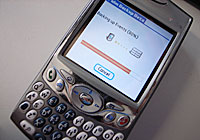 The Palm Backup Beta service can be downloaded
The Palm Backup Beta service can be downloaded  An activation letter is sent to your email account, but you can start the back up on your Treo straight away (but you must activate your Palm account within 7 days otherwise your account will be closed).
An activation letter is sent to your email account, but you can start the back up on your Treo straight away (but you must activate your Palm account within 7 days otherwise your account will be closed).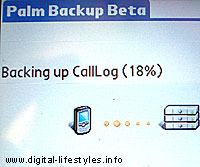 A back up of your data will then be saved to Palm’s secure server as scheduled – so long as there is wireless data coverage available (if it fails to find a connection, it will try again at the next scheduled time).
A back up of your data will then be saved to Palm’s secure server as scheduled – so long as there is wireless data coverage available (if it fails to find a connection, it will try again at the next scheduled time).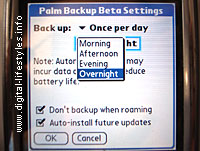
 Palm Backup Beta service currently supports Palm Treo 700p, Treo 680 and Treo 650 and there’s no news yet about release date or pricing.
Palm Backup Beta service currently supports Palm Treo 700p, Treo 680 and Treo 650 and there’s no news yet about release date or pricing.